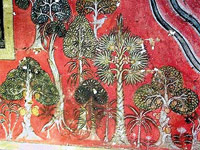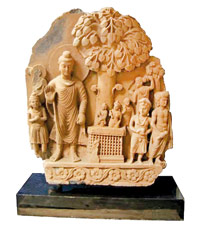Respect for trees, not worship in the time of the Buddha

A realistic depiction of trees from the DambullaMahavihara, early 19th century
March 21 is International Day of Forests. On this and similar “international days” the organising committees try to get as many elements of society involved as possible, with varying degrees of success, and with fluctuating levels of enthusiasm. Religious leaders and bodies are usually roped in to help too, and given religion’s influence in society this is only understandable.
As far as the International Day of Forests is concerned few religions could have more that is meaningful to say about forests and trees than Buddhism. Other than the actual Dhamma itself, the Tipitaka, the Buddhist scriptures, says more about plants in general and forests and trees in particular, than almost any other subject. Of course the thing that first comes to mind is the Buddha’s immediate connection with trees, the fact that he was born under a tree, had an early spiritual experience under a Eugenia jambolala became Awakened under a Ficus religiosa and passed away under a Shorea robusta. But it would be a mistake to think that this was the more significant connection between the Buddha or Buddhism and trees. It is usually assumed that Theophrastus’ Historia Plantarum of approx. 320 BC was the beginning of botany as a science and with good reason. However, the Tipitaka shows that botanical inquiry and attempts to understand plants began at least two centuries earlier with the Buddha and the first Buddhists, not as systematic as with the Greeks it is true, but rational nonetheless.
The Buddha classified plants as either medical herbs, grasses or forest trees (osadhi, tina and vanappatayo). At other times he classified them according to their mode of propagation; whether they were propagated by roots (mula), stems (khandha), joints (phulla), cuttings (agga) or seeds (bija). He considered plants to be a one-facultied life form (ekindirya). Although he did not mention which faculty they possessed he was probably referring to nastic movement and tropism, e.g. the way some flowers close at night and open during the day, and how others face more to the sun.
In the Jataka we have an early attempt to define trees: “It is called a tree because it has branches. Without branches it’s just a stake.” The Paramatthajotika defines a forest as “a collection of trees growing in close proximity to each other” (Pj.191). Some of the structural components and other parts of trees referred to by the Buddha include the roots (mula), trunk (danda or khandha), the periderm or outer bark (papatika), the phloem or inner bark (taca), sapwood (pheggu), heartwood (sara), branches (sakha), twigs (pasakha), leaves (panna or patta) and the crown (agga). There is also references to seed pods (sipatika) some of which encased the seeds surrounded by down (tula). Roots, those parts of trees and other plants that anchor them and absorb and transport water and nutrients, were identified and described. Some of the different root systems mentioned include woody roots which could be either long or short (dighamula and rassamula), tap roots and lateral roots (mulaniahogamaniyanitiriyangamani), feeder roots (naḷi), spreading roots (mulasantanaka), and hair roots (mattani). In the Sutta Nipata the aerial roots of banyan trees are called “trunk-sprung” (khandhaja). It was understood that roots absorb moisture and nutrition from the soil and that the sap (oja) moves upwards through the trunk into the branches and leaves. The Visuddhimagga says:“When a great tree is growing on the earth, nourished by the essence of humus and, with that as condition, its roots and trunk, branches and shoots, foliage, flowers and fruit grow so it fills the sky and continues the tree’s species until the end of the aeon, one cannot say that the essence of humus is only found in the roots but not in the trunk or in the fruit but not in the roots, and so on. And why? Because it spreads throughout the whole tree from the roots upwards.”
Flowers, the reproductive structures of flowering plants, were examined in detail, each part being named and described. Thus the Tipitaka mentions the stem (danda or vanta), buds (koraka), petals (patta or dala), calyx (gabbha), filament (kanjakkha), pericarp (kannika) and the pollen (renu). Despite such careful observation neither the Buddhists or other ancient Indians understood the function of these parts. The Jataka classifies flowers into two types; those growing on land and those growing in water although sometimes two more types are added, those growing on creepers and those that emerge from tree trunks or branches.

The Buddha contemplating the Bodhi Tree before sitting at its foot, Gandhara 4th century CE
Always a careful observer, the Buddha noted that “a tree that has been cut down can grow again if its root is undamaged and complete” (Dhammapada 338). However, he also observed that some plants, palm trees in particular, could not grow again if they were “cut off at the root”.
It was widely believed by the ancient Indians that gods that could answer prayers inhabited trees, just as their present day descendants do. The Greeks had similar beliefs and called tree spirits dryads. In Pali they were called rukkhadevata, vanadevata, or aramadevata). There is no place in the Tipitaka where the Buddha endorsed tree worship the way he occasionally did for worshipping gods. At Dhammapada verses 188-9 he says:“Gripped by fear people go to sacred hills, forests, groves, trees and shrines. But these are not a safe refuge, not the best refuge. Not by going there is one freed from all suffering.” In the Vinaya he also said:“People generally believe that there is life (i.e spirits or gods) in a tree”, implying that while this was a widespread notion it was not one he accepted. The several Jataka stories that poke fun at tree worship were clearly influenced by the Buddha’s rejection of tree worship.
The Buddha was not just a careful observer of trees and other plants, he also seems to have had a respect for, even a fondness for them. In comparing a good and generous person to a tree he demonstrated this. The kindly and hospitable person was, he said: “like a great banyan tree growing on the side of roads that welcomes weary travellers with its cool shade and soothes their tiredness”.
The Milindapanha made a similar comparison some 400 years later. “As a tree makes no distinction in the shade it gives, like this, the meditator should make no distinction between any beings, but develop love equally to thieves, murderers, enemies and to himself.” The early Buddhist attitude seems to have been; don’t worship trees, try to be like them!
The Buddha also told a story to illustrates the importance of respect for trees. Long ago it seems, the mythical King Koravya had an amazing banyan tree in his realm which bore fruit of exceptional sweetness. Everyone in the realm enjoyed the fruit freely and so there was no reason to guard the tree. But one day a man ate his fill of the fruit then broke a branch and went away. This act of ingratitude so incensed the tree spirit that it caused the tree to bear no more fruit. This attitude of respect for trees is expressed in these memorable words from the Petavatthu: “Of the tree in whose shade one sits or lies, not a branch of it should he break, for if he did he would be a betrayer of a friend, an evil doer… Of the tree in whose shade one sits or lies, not a leaf should he injure, for if he did he would be a betrayer of a friend, an evil doer”. Should not these words be posted at the entrance of every forest reserve and national park in the country?
Later Buddhist literature is full of beautiful passages about trees, the following being just a few of them. Ashvaghosa’s Buddhacarita compares spiritual practice to a tree “the fibres of which are patience, the flowers virtue, the boughs awareness and wisdom, which is rooted in resolution and which bears the fruit of Dhamma”.
The Mahavastu says: “The meritorious person grows like a banyan tree, while the person of meagre merit becomes stunted like a tree planted in the roadway.” In his Bodhicaryavatara, the great Sanskrit poet Santideva wrote of his longing for the peace of the forest life in these words: “The trees do not speak harsh words nor do they try to please by artifice. When shall I have the opportunity to dwell with those happy to live with the trees?”
With such a longstanding interest in and regard for trees it is only right that Buddhists take International Day of Forests seriously and do what they can to protect their country’s arboreal heritage.


